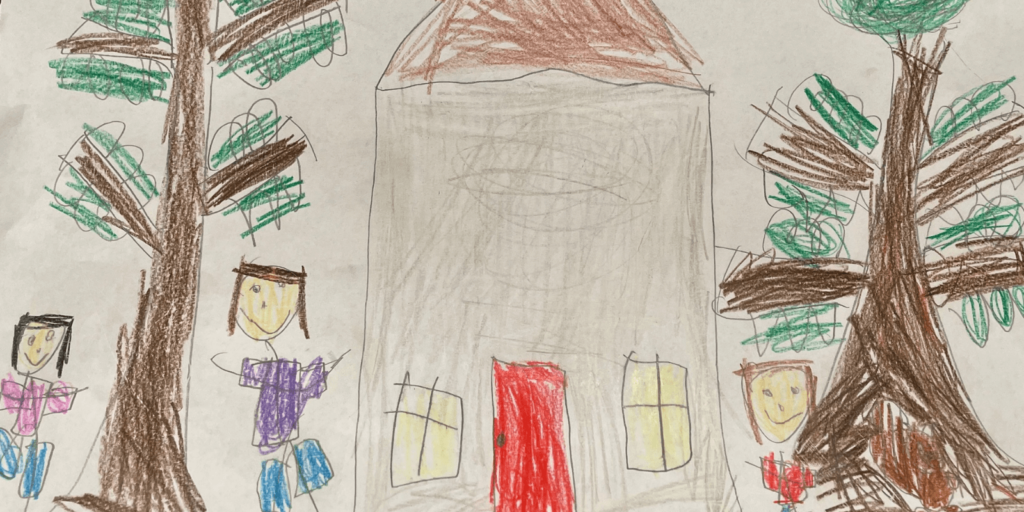Search
A House for Me
October 10, 2022
The Road to UWBA’s Housing Justice Initiative
By Ena Li, Senior Vice President, United Way Bay Area
Image by Charlotte Li
In the popular children’s book, A House Is A House For Me, author Mary Ann Hoberman explains how everything and everyone has a house. It starts off like this:
A hill is a house for an ant, an ant
A hive is a house for a bee
A hole is a house for a mole or a mouse
And a house is a house for me!
This book is poetry, sparking questions about the nature of a house, who lives in what types of houses, what types of animal habitats exist, and where these houses are located. A web is a house for a spider. A bird builds its nest in a tree. What I love about this book is the heart of its message, that all living things have houses; or at least they should if they are to live, sleep, and shelter. It seems like such a simple concept, but when I see these words on the page, I’m forced to consider a reality: for many Bay Area families, a house isn’t actually a house.
“…71% of respondents reported living in San Francisco when they became homeless, with one-third of those reporting they had lived in San Francisco for 10 years or more…”
Every other year, a Point-in-Time (PIT) Count of people experiencing homelessness is conducted by communities receiving federal funding for homeless services, as directed by the U.S. Department of Housing and Urban Development (HUD). This year, on the day of the PIT in February, in our eight Bay Area County regions, at least 36,825 people were counted as experiencing homelessness.
The San Francisco PIT Count Report 2022(PDF) showed 71% of respondents reported living in San Francisco when they became homeless, with one-third of those reporting they had lived in San Francisco for 10 years or more. As you might expect, the rates of homelessness are disproportionately high for people of color, “as a result of historical and structural racism and failed policies across many systems,” according to the report.
Median single-family home prices were $1.36 million as of May. According to the Bay Area Equity Atlas, 47% of Bay Area renters are housing burdened, meaning they spend more than 30% of their income on housing costs. We know that there simply isn’t enough affordable housing in the Bay Area for everyone who needs it, yet according to the Terner Center for Housing Innovation, building affordable housing complexes is estimated to cost $500,000 to $1 million per unit, making it incredibly cost-prohibitive for developers.
So how can a house be a house for everyone in the Bay Area?
Housing affordability and availability isn’t a new issue – it’s been a growing problem for a while now. This is why UWBA has supported better housing for Bay Area residents for almost 70 years. Here’s a snapshot through the decades.
- 1950s – UWBA focused on basic needs support for community members and organizations advocating for better housing for Black residents
- 1960s – Funded agencies that specifically helped people get housed
- 1970s – 211 began connecting Bay Area residents to housing and basic needs services
- 1980s – Began convening local leaders to provide federal Emergency Food and Shelter program funding to local agencies
As my colleague Laura stated in her blog on the Emergency Assistance Network, for more than 30 years, UWBA has also collaborated with local nonprofit organizations in Santa Clara County providing services to prevent homelessness. Through EAN, we’ve been able to assist residents facing eviction, provide rent and mortgage assistance, and meet basic needs.
UWBA felt these efforts were great at helping to keep people afloat when they needed support the most. But we knew we needed to do more.
In 2017, when community conversations revealed that the lack of available affordable housing was the number one issue in the community, we added housing to our public policy agenda.
We also launched a rental relief fund in July 2020, at a time when the economic impact of the COVID-19 pandemic and resulting closures were just beginning to be felt. If you’re interested in learning more about our “Rental Relief” efforts, this blog gives an overview of the multiple ways we address the issue and why. It’s definitely worth the read.
Last year, we doubled down on our housing efforts by launching our Housing Justice Initiative, with the goal of further advancing the housing-centric work we’ve been doing for decades. We are joining with over 30 organizations in the Bay Area that are working to advance housing justice. We’re supporting organizations with grant funding, and we’re advocating for policies that increase supply, improve conditions, and remove barriers to safe and affordable housing.
We are also planning a public will-building campaign to engage community members by encouraging them to share their stories and leverage the assets that community residents have to elevate housing as a top priority issue in the Bay Area. We are hoping to tap into the hearts and souls of our neighbors so we can ensure everyone can take action to ensure all Bay Area residents can be housed, stay housed, and become homeowners.
The bottom line is, while it may be a multifaceted and very entangled problem, housing in the Bay Area is an issue that can be solved if we choose to get together and do so. Collectively, we have the resources to make sure families aren’t constantly faced with the prospect of homelessness. Returning to Hoberman’s poetry, I found myself considering an adapted ending, something that spoke to our realities and hopes for the future:
Cartons are houses for crackers
Castles are houses for kings
The more that I think about houses,
The more we need houses for things
And once you get started in thinking this way
It seems that whomever you see
Should live in a house or own their own home
And a house should be a house for me
Do you want to be part of our housing justice journey? Do you have a housing story to share? Join us, and let’s work together so that a house can be a house for us all.



